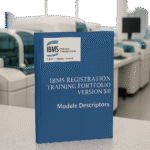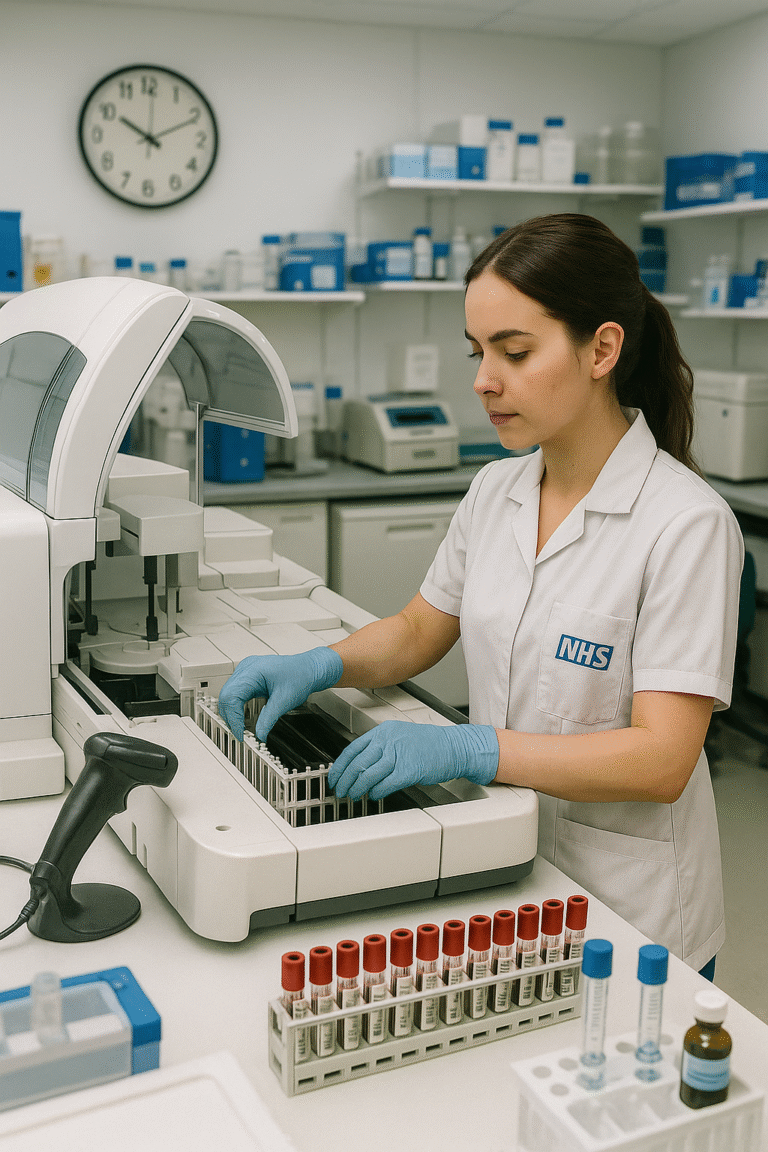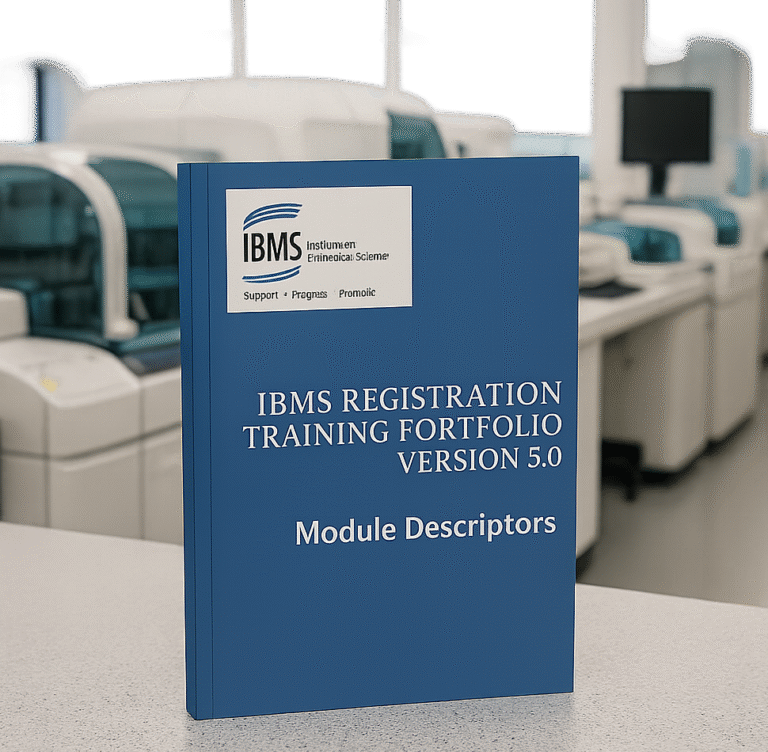Struggling with portfolio justifications? Learn how to explain your IBMS Registration Training evidence clearly and confidently using real examples mapped to HCPC Standards of Proficiency. A comprehensive guide for biomedical science trainees.
Introduction: What Is the IBMS Portfolio?
The IBMS Registration Training Portfolio is a structured and essential process for biomedical science graduates in the United Kingdom who are seeking registration with the Health and Care Professions Council (HCPC). Successfully completing this portfolio is a critical milestone on the path to becoming a registered Biomedical Scientist.
The portfolio is divided into modules that align with HCPC Standards of Proficiency (SoPs). These standards define the knowledge, skills, and behaviours required to practice safely and effectively. Each module requires evidence of learning, competence, and reflection. However, simply uploading documents or listing tasks is not enough.
You must justify your evidence—and this is where many trainees need extra support.
What Does “Justification” Mean?
In the context of the IBMS portfolio, a justification is a short written explanation that links your evidence to the relevant HCPC SoP(s). It explains:
- Why the evidence is suitable
- What it shows about your knowledge or skills
- How it proves that you meet the professional standards
Essentially, it answers the question:
“How does this piece of evidence show that I am ready to practise as a Biomedical Scientist?”
Think of it as a bridge between your daily tasks and professional accountability. Without it, assessors may struggle to understand how your evidence fits the standards, even if the task itself is well performed.
Why Is Justification Important?
Justifications are important for several reasons:
1. ✅ They demonstrate understanding
Writing a justification shows that you do not just follow procedures—you understand why you are doing them, and how they fit into safe, ethical, and professional practice.
2. 🧠 They support reflective practice
Justifications often include short reflections. This helps you develop the critical thinking needed to make informed decisions in real-life scenarios.
3. 📋 They help assessors mark your portfolio
Assessors are looking for evidence that clearly meets the SoPs. Your justification tells them exactly which standards your evidence covers, and how it does so.
4. 🎓 They prepare you for future registration audits
If you ever face an HCPC audit or fitness to practise review, having a habit of reflective justification can help you defend and explain your decisions with confidence.
What Makes a Good Justification?
A strong justification:
- Clearly states the relevant SoP number(s) (e.g., “Standard 1.1”)
- Explains what you did
- Describes how this demonstrates the standard
- Includes brief reflection, if appropriate
- Uses first-person academic writing in plain, professional English
- Is clear and concise—aim for 2–4 sentences per standard
Bonus Tip: Use SoP language
If your justification includes keywords or phrases from the standard itself, it makes the mapping even clearer for the assessor.
Structure of a Justification (Template)
Here is a simple structure you can use when writing your justification:
1. Context: What was the evidence about?
2. Action: What did you do?
3. Learning: What did you learn or improve?
4. SoP Link: Which standard(s) does this demonstrate and why?
Example sentence starters:
- “In this task, I…”
- “This demonstrates my ability to…”
- “I applied the principle of…”
- “This is aligned with SoP [number] as I…”
Extended Examples of Evidence and Justifications
Below are several expanded examples covering various modules from the IBMS V5.0 portfolio.
🧾 Evidence: Personal Statement on Supervision and Scope of Practice
Module: Section 1 – Module 1: Personal Responsibility and Development
SoPs: 1.1, 4.1, 4.5
Justification:
“This statement outlines how I was trained to perform specific laboratory tasks under supervision and later performed them independently following competency sign-off. I describe a scenario where I recognised the limits of my practice and sought advice from a senior colleague before continuing. This demonstrates SoP 1.1, as I understood when to seek support. It also shows SoP 4.1, reflecting my personal responsibility in ensuring safe practice, and SoP 4.5, as I took initiative in reviewing procedures before requesting help.”
📚 Evidence: CPD Summary with Reflection
Module: Section 1 – Module 1 or Section 2 – Module 5 (Research and Development)
SoPs: 1.3, 13.1
Justification:
“This summary details several CPD activities I have undertaken, including a laboratory audit and a quality control training session. I explain how I reflected on feedback received and used it to improve my handling of internal quality controls. This evidence supports SoP 1.3 by showing my ongoing commitment to learning. It also links to SoP 13.1, demonstrating that I change my practice in response to new information and professional feedback.”
🤝 Evidence: Equality, Diversity and Inclusion (EDI) Reflection
Module: Section 1 – Module 2: Equality, Diversity and Inclusion
SoPs: 5.1, 5.3, 2.5
Justification:
“In this reflection, I discuss how I responded to a communication barrier with a colleague from a different cultural background. I adjusted my approach to ensure clear understanding and respectful interaction. This links to SoP 5.1, which emphasises responding appropriately to different individuals, and SoP 5.3, which covers the impact of personal beliefs and unconscious bias. Additionally, it supports SoP 2.5 by showing that I upheld the dignity and values of the individual in my professional behaviour.”
🔬 Evidence: Sample Pathway Flowchart
Module: Section 1 – Module 4: Patient Records and Data Handling
SoPs: 6.1, 6.5, 9.5
Justification:
“This flowchart illustrates the sample journey in my laboratory, from receipt at the hatch to reporting results. It highlights how confidentiality is maintained through anonymised labelling and secure data systems, demonstrating SoP 6.1 and 6.5. I also explain how specimen identification is verified at multiple stages, ensuring compliance with SoP 9.5 regarding correct labelling and patient safety.”
💬 Evidence: Communication Methods Table
Module: Section 1 – Module 3: Communication
SoPs: 7.1, 7.5, 7.9
Justification:
“This table outlines different communication methods I use depending on the audience—scientific colleagues, clinicians, and service users. I describe how I adapt language and tone based on the recipient, aligning with SoP 7.1 and 7.5. For example, I use more technical terminology in MDT meetings but simplify explanations when speaking to a service user collecting a urine sample. This also demonstrates SoP 7.9 by showing how I communicate biomedical results accurately and appropriately.”
Frequently Asked Questions (FAQs)
🟡 Do I need to justify every single piece of evidence?
Yes. All evidence should be supported by a brief justification that links it to the appropriate SoPs.
🟡 Can one piece of evidence cover more than one SoP?
Absolutely. A single activity often demonstrates multiple standards. Just make sure to explain how it relates to each one.
🟡 Can I use bullet points in my justification?
Generally, justifications should be written in full sentences and in paragraph form, as they are part of your reflective writing. However, in some diagrams or structured formats, short annotations may be acceptable.
🟡 Should I reference legislation or IBMS documents?
Yes, especially when required. For example, if discussing informed consent or EDI, referencing the Equality Act 2010, IBMS Code of Conduct, or HCPC Guidance on Conduct and Ethics adds depth to your justification.
Helpful Resources
- HCPC Standards of Proficiency for Biomedical Scientists
- IBMS Registration Training Portfolio V5.0 (2023)
- IBMS Guide to Good Professional Practice
- HCPC Guidance on Conduct, Ethics and Performance
Final Thoughts
Justification is more than a requirement—it is a skill. It reflects your ability to think critically about your practice, link actions to outcomes, and align your work with professional expectations. Writing clear, reflective justifications prepares you not only for portfolio sign-off, but also for lifelong professional practice.
Your evidence shows what you did. Your justification shows that you understood it, reflected on it, and are ready to practise.
Sign up for free class
It’s easy and free!










